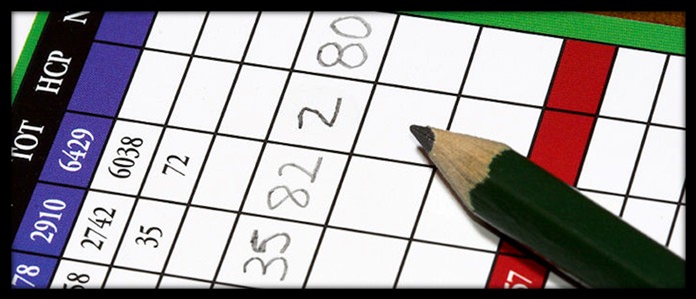Pattaya boasts many golf societies, something in excess of 40 outlets I would think. These include the bar with a sandwich board placed outside advertising golf trips, to the more serious venues, whose golfing service includes complex administration such as handicapping and local rules. The two most prominent clubs that offer full administrative services in Pattaya are the Pattaya Sports Club (PSC), and the International Pattaya Golf Club (IPGC). The former uses the USGA Handicap System whilst the IPGC uses the UK-based CONGU Handicap System.

This article will not cover why or how this divergence occurred (for another day perhaps?), but the separation has caused frustration over the years. Recently, Shane Ruddle, who runs the successful PAGS golf tournament each month, posted on Facebook an article justifying why, earlier this year, PAGS would only accept entries from golfers who had a USGA-based PSC handicap (or its offshore equivalent). On 02 November last, Shane posted that he had many people asking why the PSC-only handicap rule? His response was to refer readers to an article written by popeofslope.com: http://birdie.in.th/en/blog/knowledge-center/congu-handicaps-vs-usga-handicaps-92 .
The article, which I suspect was written some time ago, makes more than one reference to why CONGU is inferior to the USGA Handicap System. Unfortunately, many conclusions are wrong, both in fact and context. Some examples:
“Now the technical problem with the CONGU system is that it is based on T (tournament) scores only. An average golfer gets in only 3 to 5 ‘T’ scores a year. This makes the system very slow to respond to current ability. The time it takes in detecting changes in ability is often around six months. It simply does not keep pace with a player’s current skill level.”
This argument may apply in the US, but here in Pattaya where 95 percent of PSC/IPGC golf is tournament play, it couldn’t be further from the truth.
“The other point to make is that the CONGU system is slow to respond to players who are declining, since they can only go up at a rate of 0 .1 stroke per tournament round. With, say, 5 tournament rounds per year, it could take years for a declining player’s handicap to catch up with his current ability.”
This is another point at odds with the facts. Any IPGC player who submits seven consecutive scores that moves the handicap out 0.1 will automatically qualify for handicapper review.
There are other references to the CONGU’s use of CSS or standard scratch score that is used for calculating the course rating for the day. Suffice to say the CONGU system takes into account course difficulty on the day as influenced by pin placements and weather. The USGA system does not.
This popeofslpope.com article just scrapes the surface when making any serious assessment of differences between the two systems. To understand the issues further and the implications for how we administer golf here in Pattaya, the story of Golf Australia and its excursion into and out of the USGA handicap System makes for interesting reading: https://golfnutter.wordpress.com/2013/02/22/handicap-flaws/.
Motivated by a desire for handicap portability, Golf Australia (GA) adopted the USGA Handicapping System in April 2010. It took barely six months before negative feedback from clubs had reached significant levels. This concern grew such that after 12 months GA commenced a major review of its new handicap system. Amongst other things, the reviewers wanted to know why winning scores had markedly increased, and why higher handicappers were now dominating the winner’s podium in club competitions in every state. Put another way, why did a return of 36 points – often a winning score in the past – now not even get a mention, and how come lower-markers now struggled to get a look-in?
According to advice GA received from USGA experts, the problems had little to do with Slope – a mechanism giving golfers portability of handicap from one course to another. Rather, the problems were more to do with differences in golfing culture in the US compared to Australia. Culture in this context refers to the dominant form of golf played in the US compared to Australia.
Ninety percent of golf in the US is 4-ball better-ball match (4BBB) – they don’t do tournaments where individuals compete against the field. Golf, at least as far as handicapping is concerned, is totally dependent upon tournament scores in not only Australia, but also the UK and Europe. And so it should be in Pattaya also. The Golfnutter article referred to above makes this culture difference and its attendant implications a lot clearer.
Ignorance of the differences in the two systems, and what it means to golfers here in Pattaya, has been flourishing for years. In my experience, golfers who play regularly under both systems will normally see a minimal difference in their category one handicap (0-5), perhaps one shot in category two (6-12), two shots in category three (13-18) and perhaps more in category four. In nearly every case the IPGC handicap will be the lower. Experienced golf organisers know this. They also know there is no simple way around it. If a golfer has both a PSC and an IPGC handicap, then whatever system is running the day, determines which handicap they will use.
There will be circumstances that rely upon a golfer’s integrity, as indeed do the Rules of Golf. For instance, take a golfer with dual handicaps who has played only IPGC tournaments for the past six months, during which time his handicap has gone from ten down to seven. His last PSC handicap was 12. What does he play off when entering his next PSC tournament? The PSC organiser will see 12 against his name. If that is the handicap the golfer elects to play off, he is cheating and should be disqualified. And please Mr Organiser, tell the story in the press report – we want to know.
Conversely, if an IPGC 10-marker splits his golf outings approximately evenly between the two systems, yet has a 12 handicap with the PSC, then that is the number he should use when playing with the PSC. We are talking equity. Any reasonably minded person should be able to work this out.
The same principle applies when golfers return to Pattaya from their home clubs – they should play off the handicap that reflects their most recent golf – whether higher or lower, just bring the evidence.
PSC golfers wanting to try out with an IPGC society will be welcomed as will their PSC handicap. Similarly, the same goes with most PSC venues accepting a golfer using his/her IPGC handicap.
Unfortunately, there will always be the exceptions where cheats seek to prosper. The USGA system left itself wide open to abuse by allowing individuals to submit scores for handicap assessment by methods other than submitting to the course just played. Here in Pattaya, all PSC/IPGC tournament scores must be submitted to the golf organiser, signed by a competitor, that same day. But to allow golfers to submit their non-tournament scores, via internet, with or without verification, is inviting abuse. This cannot be done under CONGU.
What about CONGU’s lack of handicap portability? This is the only area where CONGU, as a handicapping system, is limited. However, does this really matter when taking into account the courses we play here in Pattaya? And do they, the courses, offer layouts consistent with their alleged USGA Course Rating? Or do the positions of tee boxes, for example, so often moved way beyond allowable USGA guidelines, render the conversion – between the golfer’s base index (base handicap) to that course’s daily handicap – redundant?
To sum up, yes we have two different handicap systems here in Pattaya, but golf organisers have, on the whole, managed to work round this. And as far as Shane Ruddle, the PAGS organiser, is concerned, he has every right to impose a one-system handicap rule for his monthly tournament. It gets rid of any dispute related to golfers with handicaps from different systems vying for podium finishes. But with the benefit of hindsight, perhaps the popeofslope .com article was not the best way to explain this.
In a recent chat with Shane, he explained that his new web-based handicap system – http://birdie.in.th/ – was designed, in part, to allow people with non-USGA handicaps to register their scores from rounds played elsewhere, and thus obtain a PAGS-compliant handicap. So for all you golfers without a PSC handicap, who want to join one of Pattaya’s more popular monthly tournaments, simply input your rounds to http://birdie.in.th/ and presto; you’re back in the game, probably with a few shots more!
Happy golfing,
Golfnutter




